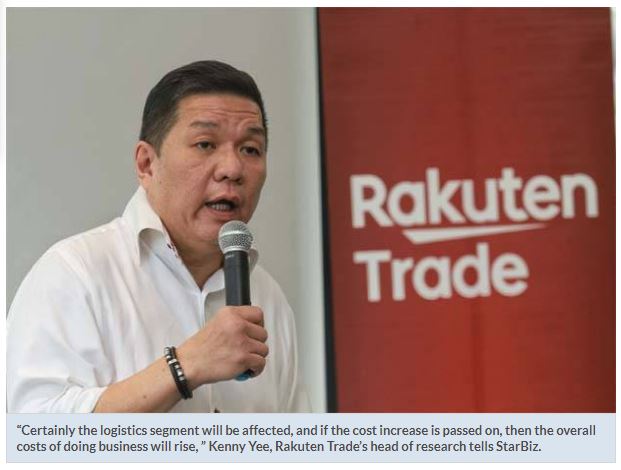Malaysia: Floating RON95 will hike transport costs
PETALING JAYA: The logistics and automotive sectors are among those that will feel the impact of the targeted fuel subsidy scheme, when it kicks off in January next year.
Higher costs for the logistics sector lead to higher transport costs for businesses, regardless of the sectors they operate in, and ultimately higher prices for products and services.
With RON95 fuel to be floated according to market prices, consumers may increasingly choose to purchase more energy-efficient or green vehicles, or opt for public transport over driving.
Currently, the price of RON95 is fixed at RM2.08 while the price of the higher grade RON97 is controlled by a floating mechanism.
Under the scheme announced by Domestic Trade and Consumer Affairs Minister Datuk Seri Saifuddin Nasution Ismail on Monday, the price of RON95 petrol will be floated from next year, while only Bantuan Sara Hidup (BSH) recipients based in Peninsular Malaysia will be entitled to the subsidy. The price of RON95 will remain fixed at RM2.08 for Sabah, Sarawak and Labuan.
About 2.9 million people are expected to be eligible for the subsidy under the scheme.
Car and motorcycle owners entitled to the scheme will respectively receive RM120 and RM48 every four months.
The subsidy will only be given to BSH recipients who own cars with 1,600cc engine and below, as well as cars that are 1,600cc and above which are at least 10 years old.
Qualified motorcycles are those that are 150cc and below, or 150cc and above if they are seven years old.
The logistics sector will be directly impacted if pump prices continue to increase above RM2.08 per litre for RON95, which means higher transports costs for businesses.
A decision on whether the price of diesel will also be floated is pending as diesel is the preferred fuel for the haulage industry. Should the subsidy on diesel be removed, then the cost impact would be greater to the economy.
“Certainly the logistics segment will be affected, and if the cost increase is passed on, then the overall costs of doing business will rise, ” Kenny Yee, Rakuten Trade’s head of research tells StarBiz.
He added that consumers would ultimately be the most impacted as a large part of these higher costs is likely to be passed on.
HLIB Research said migration towards the new petrol subsidy scheme could increase transport related costs year-on-year for businesses in 2020, if pump prices rise above RM2.08 per litre.
“For the logistics sector, we gather from Pos Malaysia that fuel cost only makes up about 2% of its total courier and postal services cost, ” the research house said in a note yesterday.
It added that the targeted subsidy would be broadly negative for the consumer sector as it was a move away from a blanket subsidy, potentially reducing total discretionary income.
In the automotive sector, it is likely that consumers will shift towards more fuel-efficient, hybrid or electric vehicles to keep fuel costs down.
The scheme is also likely to result in BSH recipients who currently own cars with engines larger than 1,600cc to switch to smaller capacity models to be eligible for the subsidy.
Analysts expect this move to benefit primarily the local carmakers, Proton and Perodua.
Noting that the maximum income for BSH recipients is RM4,000 per month, and assuming a 30% allowable loan commitment, MIDF Research estimates a maximum allowable monthly loan commitment of RM1,200.
“National car models dominate the lower price and capacity segment of the auto market, such as Perodua Axia, Proton Saga, Perodua Bezza, and are expected to be key beneficiaries, ” it said.
As for the impact on petrol station operators, analysts are divided on the impact of the scheme on Petronas Dagangan Bhd  (PetDag).
(PetDag).
Affin Hwang Capital Research believes consumer spending may see a shift towards PetDag as the company currently offers the highest fuel rebates through its loyalty card programme.
“As fuel becomes more expensive, consumers are likely to seek more attractive rebates to lower their cost of living.
“Nevertheless, we believe any incremental volume growth from grabbing market share would likely be small, ” it said.
MIDF Research, on the other hand, feels that PetDag could be impacted as consumers opt for public transportation due to the higher costs associated with driving.
The research house said this, however, would be negated by PetDag’s extensive network of 1,100 stations which have seen sales volume increases from recent refurbishment exercises.
Source: https://www.thestar.com.my/business/business-news/2019/10/09/floating-ron95-will–hike-transport-costs#AbJiDMb8WqK0R7f6.99


 English
English




